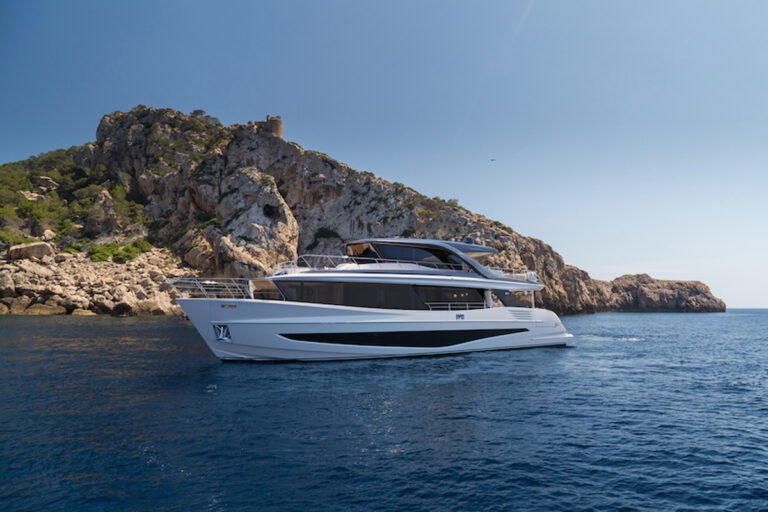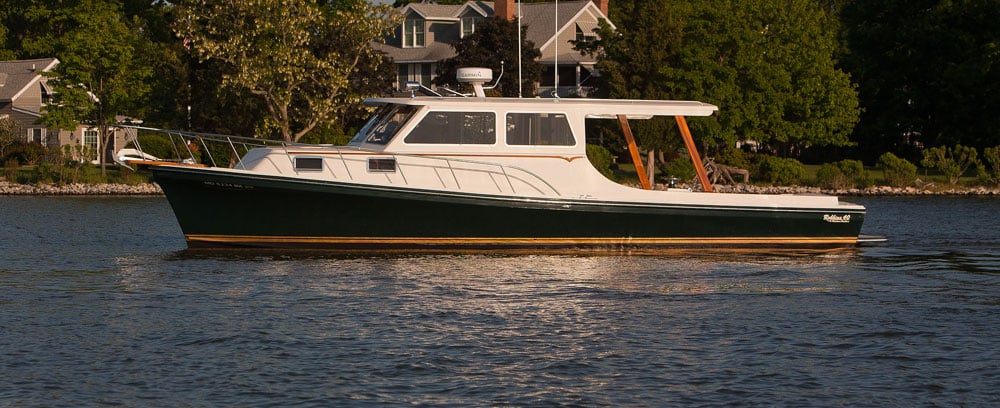
Deadrise
An overcast sky wept misty tears on me as I idled a 15-foot garvey out of a private dock in Grasonville, Maryland. I planned to explore parts of Prospect Bay’s shoreline, but a waterman’s Chesapeake Bay deadrise workboat rounded the point just north of Parsons Island and glided across my course, dry stacks barking the patois of a big-block V-8. All thoughts of exploration vanished.
About 40 feet long, narrow for her length and finished in flat white, the boat’s forefoot, sharp as a meat slicer, carved a clean trough into the bay’s choppy waters (see our extra photo gallery here). The bow wave curled like a slice of bologna, tumbled back to the surface and vanished into one of the flattest wakes I’d ever seen. She made 10 knots, maybe 12, and the bay quickly absorbed all record of her passing. A tall, angular deckhouse sprouted from the forward third of the boat, and the open cockpit stretched from the house to the transom, interrupted by only the engine box and the culling board. The freeboard seemed impossibly low by the standards of ordinary pleasure boats, but this characteristic allows the waterman to work his tongs by hand from the wide washboards. A successful day of tonging would have filled a lot of this open space with a mound of oysters, but today she was empty. The owner relaxed at the starboard-side helm console, his fingers loosely wrapped around the fore-and-aft tiller.
Deadrise motor-workboats and their modern recreational descendants evolved directly from the sailing skipjacks of the late 19th century. Skipjacks are remarkably elegant, V-bottom, shallow-draft workboats, rigged with a leg-o-mutton (triangular) mainsail and small jib. Watermen developed the skipjack in response to the forces of supply and demand in the businesses of oystering and crabbing. These boats were relatively easy and economical to build, could carry a great load and were powerful enough to tow a dredge — characteristics that addressed the inadequacies of the log canoes, log-bottom brogans and bugeyes that watermen employed earlier in the century.
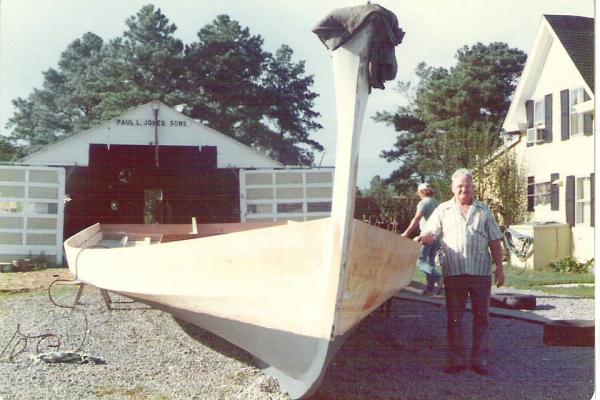
A great many watermen built boats for themselves, and when one of them produced a particularly handsome and able craft, his cronies often asked that he duplicate the model for them. That’s how oyster fishermen and crabbers became boatbuilders. These watermen/boatbuilders didn’t know how to draw plans and make offsets. They simply built boats by eye, maybe carving a model before laying the keel.
Rack of Eye
The phrase rack of eye rings mysteriously in the mariner’s mind, but it simply means building a boat without the use of plans. The technique requires a lot of experience and sensitivity to the way the shape of each hull influences a boat’s behavior.
Local traditions and prevailing conditions in various areas of Chesapeake Bay generally determined the appearance and scantlings of the deadrise above the waterline and below. Boats that were built for the watermen of the Hampton Roads area, for example, wore stronger planking to withstand the rough waters of the lower Chesapeake. Along Maryland’s eastern shore, watermen required a shallower draft to work the thin waters of the bay’s tributaries. Everywhere on the bay, each waterman built or specified the shape and size of the deckhouse and the location of the tiller or wheel.
In spite of these variations, the boats shared two important characteristics below the waterline: a steep, sharp entry and shallow V-shape run that became flat, or nearly so, at the transom. Although some watermen preferred fore-and-aft planking for the bottom, especially in northern parts of the bay, the builders of Deltaville, Virginia, and other towns on the bay’s lower western shore preferred cross-planking (planks placed athwartships from keel to chine). This saved time and money.
During the early days of the transition from sail to power, builders copied the beam-to-length ratio of the contemporary skipjacks and even tucked up the run to the same degree — referred to as the tuck stern. This practice made sense, because the one-lung and two-cylinder marine engines of the time didn’t have the power to propel the boats beyond displacement speed. Even the discarded automotive engines that watermen adapted weren’t powerful enough, but that would soon change as automakers developed new models and more powerful engines.
The increase in horsepower revealed a deficiency in displacement deadrise boats. The stern squatted dramatically when the oystermen tried to exceed the boat’s theoretical hull speed. Something had to be done. One of the successful fixes was the settling board, a stationary trim tab that spanned the entire beam at the transom. A variety of shingles, which created a degree of concavity in the after sections, also helped to reduce squat. Built-in concavity was the most elegant solution to this problem. Builders curved the horn timber (the piece of wood that ties the keel to the transom) and cross-planked the after sections accordingly. This hook in the bottom abaft the skeg eliminated most of the speed-robbing squat. The boats were able to plane, after a fashion, though they probably failed to reach the speed/length ratio of a modern V-shape planing hull.
By the middle of the 20th century, the builders had gotten it right. The forward sections remained much as they had for 40 years, but the run became straight (parallel buttock lines) all the way to the transom. Watermen also asked for beamier boats, which permitted a higher payload and enhanced planing. The deadrise, which gave the boats their generic name, remained. Nowadays, you’d have a difficult time finding a deadrise commercially built the old way. Most of the boats are fiberglass, a few are cold-molded wood and fewer still are aluminum.
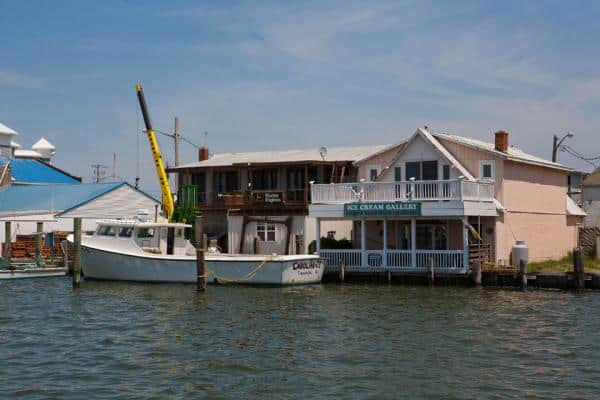
The deadrise type has gained popularity as a recreational craft and charter fishing boat. We visited three active shops — two in Denton, Maryland, and one in Crisfield, Maryland — to see how they’ve developed the deadrise type to meet the modern yachtsman’s needs.
Mathews Brothers
Pete Mathews and his brother, Bob, moved to Easton, Maryland, early in the 1960s and spent a lot of time around boats on the Tred Avon River. “I just love the area,” Pete says. The brothers, both of whom have a lot of experience in woodworking, also fell in love with bay boats. They’d worked at Knapp’s Narrows Marina on Tilghman Island and began building the 19-foot Hampton one-design sailboat. When Cecil Robbins’ shop came onto the market in 2002, the brothers bought the land and the tooling for the deadrise boats that Robbins had been designing and building since 1973. A short time later, they moved the business to Denton, Maryland.
“The hulls are proven on the bay and beyond,” Mathews says. They have the signature sharp entry and nearly flat after sections of the early deadrise boats. Combined with a relatively broad beam, the bottom gives these Robbins designs great stability. “They’re easily driven,” Mathews says, “so they’re economical to run.” The Mathews 40, powered by a single 500-horsepower Yanmar diesel, burns about 15 gallons of fuel per hour at a cruising speed of 15 to 18 knots. River Rat, the Mathews 40 that I drove, is powered by a 575-horsepower Caterpillar C9. She burns 20 to 22 gallons an hour at her 20-knot cruise. Majestic is the best way to describe the boat’s handling. The steering was light and positive, and the boat leaned outboard just a little during turns at cruising speed.
Although the hull is seaworthy, Mathews doesn’t suggest taking her offshore. “You don’t want to have windows that far forward if you get into nasty seas out there,” he says. “You don’t want 16 feet of cockpit that can fill up either.” Mathews says that River Rat is by far the fanciest, heaviest and most well-equipped boat he’s ever built. To duplicate her now would cost about $700,000. Mathews Brothers, 410-479-9720; www.mathewsboats.com
Chesapeake Boats
Dave Mason was a waterman for 20 years before he started building boats for a living. His shop is in Crisfield, Maryland, but he builds boats to the Deltaville, Virginia, model. Chesapeake Boats builds the larger custom models from AA and AB plywood and sheathes the hulls with fiberglass set in polyester resin. Mason doesn’t see the need for epoxy, and he’s never had a problem with the resin he uses. Mason builds by rack of eye, and cold-molding the custom boats lets the team easily adjust shapes and dimensions to suit the owner’s requirements.
The aesthetics of Mason’s boats recall those of the traditional deadrise models, but the superstructure is a lot larger, because most of his pleasure boat customers want a large pilothouse and spacious accommodations. Some of his boats have a clipper bow and others the traditional straight stem. The wooden boats have wide chine flats along the run, which enhance planing and improve stability; moderate deadrise aft; and a high chine in the forward sections to deflect spray. These elements set his hulls apart from the early deadrise workboats. Mason said that a typical 50-footer powered by a single 600-horsepower Cummins has a top speed of about 30 knots. Chesapeake Boats, 410-623-2293; www.chesapeakeboats.com
Judge Yachts
Bill Judge has been building boats for about 20 years. Although he likes and understands the traditional deadrise type, he wanted to build something that honors tradition above the waterline but rides on a modified V-hull, weighs less, has enough freeboard to handle big seas and is much faster than a traditional deadrise. In the design of his boats, he’s eliminated most of the keel and given the after sections a deadrise of 10 degrees. The entry remains steep and sharp, but he’s rounded the hard knuckle where the stem and keel meet, which was common on the early workboats.
The Oxford 37 Overnighter shows how much tradition influences the shape of the house and trunk cabin, but the structure is much larger than any found on a workboat. Judge has equipped this boat for comfortable and luxurious cruising. Her dry weight is about 12,500 pounds, and she’s powered by a single 480-horsepower Cummins QSB 5.9-M diesel. Her top speed is more than 30 knots. At her 28-knot cruise, she burns 18 gallons an hour. Judge Yachts, 410-479-9770; www.judgeyachts.com
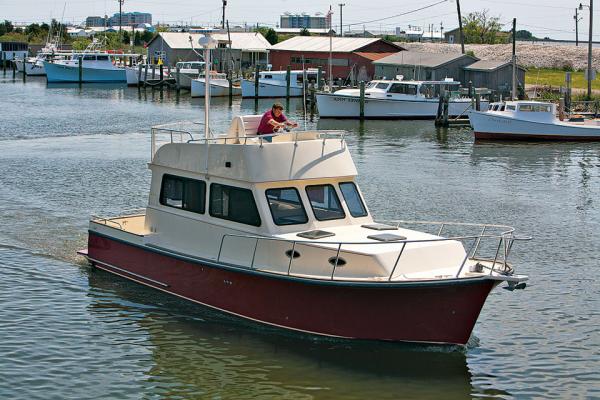
_
The Future_
Each of these builders relies on word of mouth and the Internet to spread the word about their boats. The designs are practical and seaworthy and can serve their owners very well, no matter where they use the boats. Although traditionalists have mourned the passing of wooden deadrise boats, and some of them have banded together to save the ones that remain, the style won’t disappear. The type simply thrives in other forms. “The watermen of the bay would have kept it alive no matter what,” Pete Mathews says, “because they think it’s the only boat to have.”







